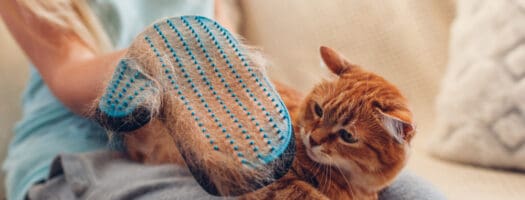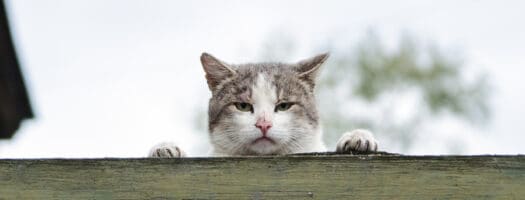The 8 Best High Fiber Foods for Your Cat in 2025
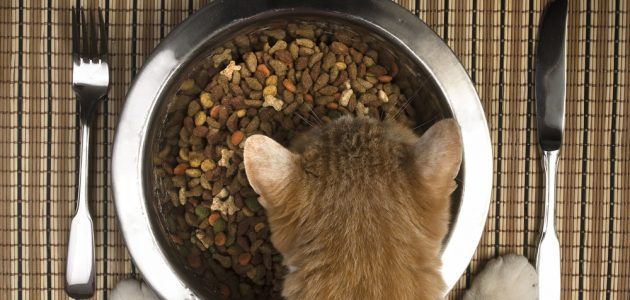
Cats have vastly different dietary needs than us, or our canine friends. Or armadillos. Everyone is different. Still, we might not put much thought into what we put into their bowl—but we should. Our Garfields don’t have the same nutritional needs as their free-roaming relatives. Indoor cats need a balanced diet, optimal for their particular metabolism.
While high fiber diets are not necessary for most cats, in many cases, this is the ideal solution to keep them healthy. If your cat is obese, has a regular issue with hairballs, or suffers from diarrhea or constipation, it’s worth asking your vet is a high fiber diet is right for them.
Luckily, you don’t need to begin a quest for the best high-fiber cat foods available today, though: we’ve already located them for you. Read on to find more about them and why they might be the top choice for your four-legged companion.
- How to Choose the Best High Fiber Food for Cats
- Top 8 Best High Fiber Foods for Your Cat 2025
- 1. Best Overall High Fiber Food for Cats: IAMS Proactive Health Weight & Hairball Control
- 2. Best Premium High Fiber Food for Cats: Hill's Science Diet Urinary & Hairball Control
- 3. Best High Protein and High Fiber Food for Cats: Blue Buffalo Wilderness High Protein
- 4. Best Budget High Fiber Food for Cats: Purina One Indoor Advantage
- 5. Superfood for Cats: Rachael Ray Nutrish Superfood Blends
- 6. Best High Fiber Food for Cats With Allergies: Natural Balance L.I.D. Grain-Free
- 7. Easiest-to-Digest High Fiber Food for Cats: Royal Canin Sensitive Digestion
- 8. Best High Fiber Supplement for Cats: Raw Paws Organic Pumpkin Powder
- Everything You Need to Know About Fiber and Your Feline
How to Choose the Best High Fiber Food for Cats
Before we dive into the best high fiber foods on the market, let’s explore the most vital info to know before you make your selection.
What Can Fiber Help Your Cat With?
There are few health issues that a high fiber food can help your cat with, like constipation. Here, we break down a few of the other more common ailments that fiber can help with.
Diet Management
The introduction of more fiber in your cat’s food can also help you manage their diet. An increase in fiber content can help your cat feel full after eating, for longer. At least theoretically, this should lead to fewer visits to the food bowl, less food consumption, and fewer calories.
Diabetes
A diet rich in soluble fiber can also help diabetic cats. Diabetes is directly related to weight and is affected by high blood glucose. Soluble fiber can reduce the calories and glucose absorbed by the body during digestion. Thus, it can help in two ways, reducing sugar levels in the short term, and assisting in losing weight in the long term.
Eliminating Hairballs
If your cat has long hair or is over-grooming, you are probably familiar with the concept of hairballs. Foods that include both soluble and insoluble fiber, like Hill’s Science Diet Dry Cat Food, can help with this problem.
We’d prefer to avoid getting into the gross details. Let’s just say that a mix of solid and semi-liquified fiber can “help the hair pass through.” Thus, your purr-buddy will be able to “deposit” them at the litter box instead of suddenly launching them at your pillow.
Factors to Consider in a Higher Fiber Food for Cats
When choosing the right food for your furry best friend, keep these important considerations in mind.
Does It Have Healthy Sources of Fiber?
Some sources of fiber can wreak havoc to your cat’s stomach. Others can have the opposite effect, assist in digestion, and keep them happy and healthy. By paying a closer look at the fine print, you can ensure it contains fiber your pet pal can digest easily.
You should go for a number between 1% and 10%, with the amount considered optimal for a housebound feline’s diet being around 3%. Those fiber sources include:
- Apples
- Barley
- Beet
- Broccoli
- Carrots
- Flaxseed
- Fruit Extracts
- Pumpkin
- Rice
- Sweet Potatoes
We should note that cats don’t have a high thirst drive and get a significant amount of water from their food. That’s why you should avoid food sources that contain large amounts of corn, grains, or wheat, that absorb water when digested.
Is Protein a Primary Ingredient?
Even when choosing a high-fiber food for your cat, you should pay attention to the sources of protein in it. Good protein sources for our mini carnivores come from real meat, which should be a cat food’s primary ingredient. Chicken, duck, turkey, or salmon can be a great first ingredient for a cat recipe. Animal byproducts and any mention of “meals?” Not so much.
To be clear on this, it’s not a negative if a cat food contains animal byproducts or stuff like “chicken meal.” Some “filler content” is expected, helps enrich the recipe, and isn’t bad on its own. Still, it shouldn’t be the primary ingredient.
Is the Brand Safe & Reputable?
It should also go without saying that you should prefer reputable brands that use safe ingredients. Avoid any brand you haven’t ever heard of or no-name options whose ingredients you can’t check.
Since the trip to your house can be quite adventurous, also make sure to check out the packaging. While researching product availability for this guide, we’ve run into unfavorable reviews for practically all brands. One common point between them wasn’t the food’s or brand’s fault: tempered or destroyed packaging. If the packaging isn’t pristine, consider the food inside it unsuitable for consumption, and avoid offering it to your purr-pal.
Does It Meet Your Cat’s Needs?
Finally, your choice should be the best for your furball. Your diabetic and lethargic pawed partner, who’s kept you company for more than a decade, won’t have the same nutritional requirements as the healthy and energetic kitten you adopted yesterday.
Before making the purchase, though, it would be better to ask your veterinarian for their opinion. Maybe they’d suggest you use a supplement instead of switching to a higher fiber food for your cat. Plus, there’s always the chance your feline’s particular nutritional demands call for less fiber in their diet instead.
Now that you know what to look for in a high fiber food for your cat, let’s check out the best options on the market right now.
Top 8 Best High Fiber Foods for Your Cat 2025
1. Best Overall High Fiber Food for Cats: IAMS Proactive Health Weight & Hairball Control
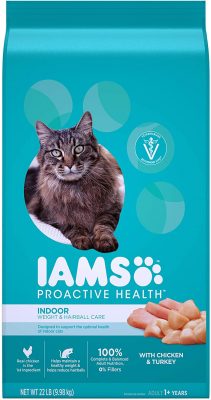
Editor’s Rating:
Why we like it: A balanced choice for cats enjoying their lazy indoor life.
Quick Facts:
- Type: Dry
- Flavors: Chicken
- Primary Ingredient: Chicken
- Secondary Ingredients: Chicken, Chicken By-Product Meal, Corn Grits, Corn Gluten Meal, Ground Whole Grain Sorghum
- Protein: 28%
- Fiber: 6.5%
- Fat: 11%
- Calories: 274 kcal/cup
Indoor life turns most cats into “Garfields.” They spend most of their day sleeping, bar the occasional zoomies crisis, or chirping at the birds and squirrels on their cat-TV (that we humans call “the window”).
The IAMS Proactive Health Weight & Hairball Control was created from scratch to cover most nutritional needs of our domesticated tiger-wannabes.
Although, admittedly, its fiber content is somewhat on the high side, at 6.5%, it’s far from what you’d call excessive. Instead, it complements the 28% of protein and 11% of fat, rendering this option one of the best-balanced diets for indoor cats.
We believe the recipe’s ingredients are far from optimal, though. Real chicken meat might be at the forefront but is directly followed by chicken byproduct. The other three primary ingredients are derived from corn and grain, which are harder to digest.
Pros
- Rich - but not excessive - fiber content
- Nice balance of protein, fat, and fiber
- Low calories
- Great for our lazy older furballs
Cons
- Not optimal for younger, ultra-energetic purr-pals
- Not the best choice of cat-friendly ingredients
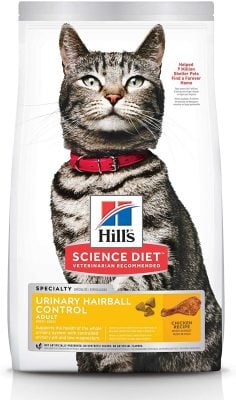
Editor’s Rating:
Why we like it: Fight hairballs and avoid urinary obstructions with the top choice in fiber content.
Quick Facts:
- Type: Dry
- Flavors: Chicken
- Primary Ingredient: Chicken
- Secondary Ingredients: Chicken, Whole Grain Wheat, Corn Gluten Meal, Pork Fat, Powdered Cellulose
- Protein: 34.2%
- Fiber: 9.3%
- Fat: 18.8%
- Calories: 324 kcal/cup
Hill’s formula offers a nice balance of protein, fat, and calories, but also contains the highest amount of fiber out of all our picks, at 9.3%. This combination makes it an ideal choice for felines on a diet, since the higher than usual fiber content can make them feel full with less food.
As its very name states, its ingredients also help with hairball control and keeping urinary tract problems at bay.
They are far from optimal choices, though. Out of its top five ingredients, only the primary one, chicken, is truly great for our cats, followed by pork fat in the fourth place.
Although we’re looking at cat foods rich in fiber, 9.3% is over three times the amount considered optimal for the average cat.
Because of its excessively high fiber content, it would be better to consult your vet before switching your cat to this particular food.
Pros
- All the fiber in the world
- Nice balance of protein, fat, and calories
- Can help with both hairballs and urinary tract health
Cons
- Too-much-fiber for the average healthy cat
- Pricey
3. Best High Protein and High Fiber Food for Cats: Blue Buffalo Wilderness High Protein
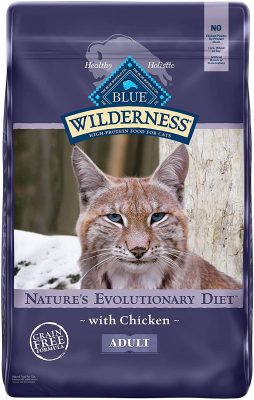
Editor’s Rating:
Why we like it: If your purr-pal needs plenty of protein, plus high fiber, look no further.
Quick Facts:
- Type: Dry
- Flavors: Chicken, Duck, Salmon
- Primary Ingredient: Meat
- Secondary Ingredients: Deboned Chicken, Chicken Meal, Turkey Meal, Potato Starch, Fish Meal
- Protein: 40%
- Fiber: 4%
- Fat: 18%
- Calories: 443 kcal/cup
As a carnivore, your cat needs protein to thrive. In that regard, Blue Buffalo’s Wilderness High-Protein looks like the best available option, with a protein content of 40%. It also has one of the highest amounts of calories compared to the alternatives, at 443 kcal per cup.
This combination makes it an excellent option for younger and energetic cats, long past the kitten stage, but still relatively hyperactive compared to three or four-year-old adults. The fiber content is close to optimal, at 4%. Blue Buffalo’s offering should also be suitable for the more sensitive cats among us since it’s also grain and gluten-free.
Nothing’s perfect, though, and Blue Buffalo’s option is no exception. Although there is no way to know for sure without a lab analysis, much of its protein content could come from the peas, which are close to the top in the list of ingredients.
Strangely, just like too much fiber can be bad for a cat, the same applies to excessive protein. Some people claim their pets fell sick after a transition to this cat food. The most probable reason they might be ignoring is that, depending on their particular metabolism, older cats may not need as much protein as youngsters.
Thus, this is another case of a cat food that excels in one regard, but for which it would be better consulting your vet.
Pros
- More than enough protein for your purr-pal
- High caloric content, optimal for young, energetic cats
- Almost the perfect amount of fiber
- Primarily based on real meat sources
Cons
- Excessive protein may be incompatible with older felines
- A large amount of protein might come from peas instead of animal sources
4. Best Budget High Fiber Food for Cats: Purina One Indoor Advantage
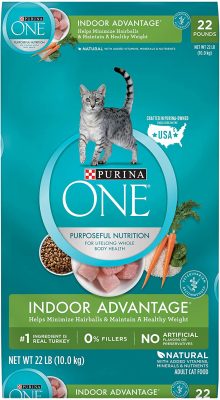
Editor’s Rating:
Why we like it: It offers a good-enough, balanced diet for those on a budget.
Quick Facts:
- Type: Dry
- Flavors: Turkey, Ocean Whitefish
- Primary Ingredient: Turkey
- Secondary Ingredients: Turkey, Brewer’s Rice, Corn Gluten Meal, Poultry By-Product Meal, Soybean Meal
- Protein: 38%
- Fiber: 5.1%
- Fat: 9%
- Calories: 398 kcal/cup
It’s true that both from a nutritional and quality standpoint, Purina One’s Indoor Advantage is far from the best food for your cat. The recipe starts nicely, with turkey as its epicenter. Then, it goes downhill, relying too much on too many “>questionable ingredients. That, though, is if you don’t take into account the asking price.
When keeping in mind that Purina One’s Indoor Advantage a more wallet-friendly option than the alternatives, some lower-quality ingredients, and extra filler should be expected.
From a nutritional point of view, it can be considered the equivalent of fast food for your pawed companion. It offers an adequately balanced diet, with 38% protein, 9% fat, 5.1% fiber, and a higher than average 398 kcal/cup.
In other words, not unlike fast food for us humans, it’s not the best, nor the healthiest of options. But just like fast food, it’s affordable, tasty, and many rely on it as their sole source of nutrition.
Pros
- Affordable
- Rich in both protein and fiber
- Real turkey as the primary ingredient
- A tasty fast-food equivalent for your pet-pal
Cons
- Not the best ingredients
- Healthier options available for not much more
5. Superfood for Cats: Rachael Ray Nutrish Superfood Blends
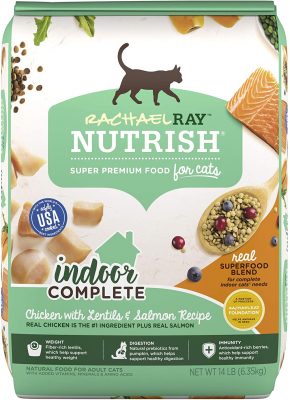
Editor’s Rating:
Why we like it: A highly original recipe with all the fiber your cat needs - and then some.
Quick Facts:
- Type: Dry
- Flavors: Chicken with Lentils and Salmon, Turkey with Chickpeas and Salmon, Chicken with Chickpeas and Salmon
- Primary Ingredient: Chicken
- Secondary Ingredients: Chicken, Chicken Meal, Brewer’s Rice, Dried Peas, Corn Gluten Meal
- Protein: 34%
- Fiber: 8%
- Fat: 12%
- Calories: 352 kcal/cup
Rachael Ray’s Nutrish Superfood Blends has an apt name since it’s the closest equivalent for cats to what we’ve come to call superfoods. It builds on chicken with lentils, salmon, rice, dried peas, and more, creating a combination that should be perfect for every feline in need of a diet.
In some cases, though, that last part can be a bit of a problem.
At first glance, the ingredients look well thought-out. There is more protein and fat than fiber and just the right amount of calories. The combination of fermentable and not-fermentable fiber can both assist in digestion and offer a feeling of fullness. So, where’s the problem?
An 8% content in fiber may be too high for many cats. It should be a perfect choice, in short bursts, when trying to help a cat with an upset stomach. For more extended periods, though, as with Hill’s Science entry in our list, you should probably consult your vet to ensure it would be a good option for your furry companion.
Pros
- Highly original recipe
- Lots (and lots) of fiber
- Real chicken as the primary ingredient
- Quite affordable for a premium option
Cons
- Protein and fat take a hit for fiber
- Too much fiber might be unhealthy in the long run - consult your vet
6. Best High Fiber Food for Cats With Allergies: Natural Balance L.I.D. Grain-Free
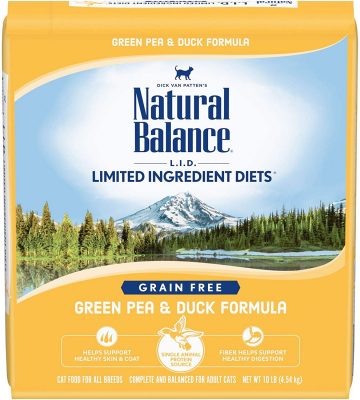
Editor’s Rating:
Why we like it: For felines whose allergies flare up at the slightest hint of corn, wheat, or soy.
Quick Facts:
- Type: Dry
- Flavors: Green Pea & Chicken, Green Pea & Duck, Green Pea & Salmon
- Primary Ingredient: Green Peas
- Secondary Ingredients: Green Peas, Duck, Duck Meal, Pea Protein, Canola Oil
- Protein: 29.5%
- Fiber: 5%
- Fat: 11.5%
- Calories: 400 kcal/cup
Corn, wheat, and soy are quite popular as both sources of fiber and filler content in many cat foods. Unfortunately, some cats are allergic to one or more of those ingredients, severely limiting their commercially available food options. This one’s for them.
As a “limited ingredient” formula, Natural Balance’s L.I.D. Grain-Free uses a select few ingredients, which can cover most of your cat’s nutritional needs. Still, some people might frown at green peas being the main ingredient. That’s not what a cat would eat in the wild.
The numbers, though, are good enough, with 29.5% protein, 11.5% fat, 5% fiber, and a somewhat high 400 kcal/cup.
Natural Balance’s L.I.D. Grain-Free is an excellent choice for purr-pals with allergies or sensitive stomachs, who can’t tolerate specific ingredients or complicated recipes. That’s not only because it lacks corn, wheat, and soy, but also because it’s grain-free, doesn’t include artificial flavors, and doesn’t mix meat sources.
To clarify this last bit, if it says “chicken” on the label, it’s chicken you get. Not duck, nor salmon. Still, if your cat prefers duck or salmon, Natural Balance offers those alternatives, too.
Always on the side of green peas, though.
Pros
- No corn, wheat, soy, or questionable ingredients
- Each flavor sticks to a specific type of meat
- Good sources of fiber
Cons
- Low, primarily plant-based protein content
7. Easiest-to-Digest High Fiber Food for Cats: Royal Canin Sensitive Digestion
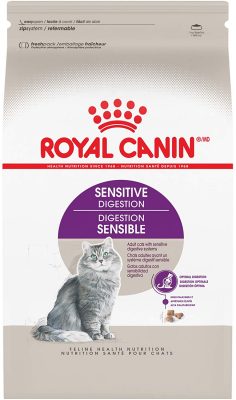
Editor’s Rating:
Why we like it: This high-fiber formula is easier on sensitive stomachs but is still filled with energy
Quick Facts:
- Type: Dry
- Flavors: Variety
- Primary Ingredient: Chicken
- Secondary Ingredients: Chicken Meal, Brewers Rice, Corn Gluten Meal, Chicken Fat, Wheat
- Protein: 33%
- Fiber: 3.1%
- Fat: 20%
- Calories: 472 kcal/cup
If your cat has a sensitive stomach, you don’t have to turn to overly conservative options like Natural Balance’s L.I.D. Indoor Grain-Free. Instead, it’s worth trying Royal Canin’s Sensitive, with a formula that promises easier digestion.
This, too, is basically a limited ingredient food, but Royal Canin followed a different approach in its recipe: instead of trying to match individual ingredients, they targeted proteins. Then, they chose the ones that are both easy to digest and offer high nutritional value.
That’s why Royal Canin’s offering has similar levels of protein content to “normal” cat foods, at 33%. Although fat is a good-to-high 20%, the fiber content is on the low side compared to the other foods on our list. Still, it’s a cat-hair over what’s generally considered optimal, at 3.1%.
What’s more than high are the calories, at 472 kcal/cup. Combined with how it’s easy on the stomach and has a (comparatively) low amount of fiber, it’s a great choice for underweight cats who need more energy and less filler.
Unfortunately, another relatively high thing is its price, making Royal Canin Sensitive Digestion is a premium option. Your purr-pal might enjoy it, eat more, and thrive, but your wallet won’t.
Pros
- Easy to digest but rich in protein and fat
- Optimal amount of fiber for the average cat
- Meat-derived proteins in the top-5 ingredients, with chicken as the primary one
- Great formula content for underweight cats
Cons
- Fiber's on the low side for a "rich in fiber" food
- Expensive
8. Best High Fiber Supplement for Cats: Raw Paws Organic Pumpkin Powder
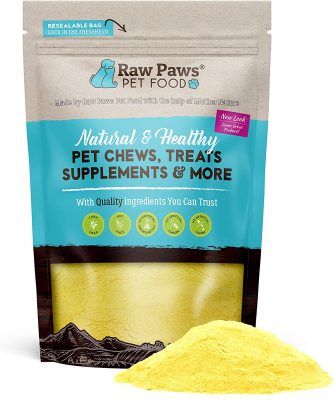
Editor’s Rating:
Why we like it: The best way to add fiber to your cat's existing diet.
Quick Facts:
- Type: Powder Supplement
- Flavors: Pumpkin
- Primary Ingredient: Pumpkin
- Secondary Ingredients: None
- Protein: 4%
- Fiber: 40%
- Fat: 0.5%
- Calories: 108/oz
Your cat could be a picky eater, or you might not want to jump to a different food. In both cases, it’s still possible to add more fiber your furball’s diet, without any radical changes: add some pumpkin.
Cats can eat pumpkin, and many even enjoy its taste. As a bonus, it helps with diarrhea. Half a teaspoon in their existing food can add a bit of fiber to their diet – although it’s still far from what you’d find in options that are high in fiber content from the get-go.
Since it comes in powder form, it’s easy to introduce to your pet-pal’s existing food. If you’re planning to enrich your cat’s existing food with fiber with it, start by adding only a hint. This will keep the flavor close to the original, and your feline probably won’t mind. Then, day-by-day, progressively increase the dosage.
Fiber can be useful for your feline pal’s “internals,” until it becomes too much. Raw Paws Organic Pumpkin Powder acts as a “fiber booster,” and has a very high fiber content. It’s not easy, though, to estimate how much powder to add to the existing food to achieve the optimal amount of fiber for your cat’s particular metabolism. Thus, it would be better to consult your vet before introducing such supplements.
It’s also worth considering how it’s an extra cost on top of your furball’s existing food. A switch to a different food that’s already rich in fiber, like Hill’s Science Diet in our list, can be both cheaper and easier to manage.
Pros
- Can "upgrade" your furball's existing food
- Powder form helps in its progressive introduction to your cat's diet
- Very high fiber content
- Can help with diarrhea
Cons
- Not easy to estimate how much to use
- Extra cost on top of the existing food, when you could be using a single but fiber-rich option
Everything You Need to Know About Fiber and Your Feline
We saw the basics about how to choose a high-fiber food for your cat, and some of the best products available. How did we come to pick those choices over the alternatives? What else should you look for when choosing a high-fiber food for your cat? Is there a reason for your constipated feline friend to celebrate Halloween by enjoying some pumpkin?
Pour a cup of your favorite beverage, ensure your cat won’t start jumping on your keyboard, and scroll down for the answers to those burning questions – and more.
Feeding Indoor Cats
Our cats are obligate carnivores, which means that the optimal diet for them, at least when in the wild, consists of small prey, like birds and rodents. After consuming those “delicacies,” non-digestible parts like fur, bones, and feathers, end up traveling through the whole digestive system. In the process, they help clean the intestines.
Since an indoor cat’s food doesn’t contain such – gross to our human eyes – tasty bits, grain can replace them to both offer similar “services” and enrich our pet pal’s diet.
Also, feral cats live a rough life. They have to be more energetic to hunt for food and avoid becoming prey for larger animals. And it’s not as if they enjoy searching for scraps in our garbage.
In contrast, our household cats spend most of their day sleeping, except when they eat, make a donation to “our” litter box to keep us happy, or get the zoomies. So, to make a long story short, what should they eat?
How Are Indoor Cats Different?
Thanks to their less energetic lifestyle, indoor cats usually need fewer calories than the cats who go on daily adventures outside.
Strictly indoor cats can also get more easily frustrated since they don’t have many venues to vent their stored energy. For some, this translates to extended grooming, which in turn leads to hairballs. If that sounds like your cat, there are food formulas precisely for that, like Hill’s Science Diet Urinary & Hairball Control.
Does Age Matter?
Young kittens are little hyperactive balls of fur who need lots of energy to thrive. As they get older, they become less active. They develop preferences and sensitivities, and need a more balanced diet, like what IAMS Proactive Health Weight & Hairball Control offers.
Then, you blink, and they’re old. Not “older,” plain “old,” and their age shows. Unlike their everlasting devotion to you, their kidneys and livers might start failing. That’s when it’s time to, once more, introduce them to a different, “lighter” type of food, like Royal Canin’s Feline Health Nutrition Sensitive Digestion Dry Adult Cat Food.
How Much Should You Feed Them?
Just like us, our cats need different types and amounts of food throughout their life. You should consult your vet about how much you should feed your cat – and what.
Still, most commercially available cat foods target specific age groups, address their particular nutritional needs, and suggest a serving size on their packaging.
How Many Calories Do They Need?
We should stress once more that your furball is an individual and could have particular dietary needs, on which only your vet could comment with authority.
That said, a relatively healthy adult cat needs an average caloric intake of around 20 times its weight in pounds.
Food Transition
Cats don’t like surprises and are creatures of habit. An abrupt change in their bowl might come as a shock to them, refusing to even look at it. In a worst-case scenario, they might even have an it-wasn’t-actually-an-accident on your bed. That should show you how much they disagree with your choice of salmon-with-peas.
Low and Slow
When transitioning your four-legged friend from one food to another, do it gradually. Slowly introduce the new food into the older one. Day by day, increase the amount of the new food, easing your cat into it.
Keep the Flavor
Apart from a slow transition from one food to another, it also helps if you choose a similar flavor. Your purr-pal will be able to tell it’s different, but probably won’t mind a transition from chicken-and-this to chicken-and-that, instead of an abrupt switch to anything-with-salmon. That’s one of the reasons many cat foods, like Natural Balance’s L.I.D. Indoor Grain-Free Dry Cat Food come in multiple flavors.
Tolerances and Benefits
Whenever you introduce a new type of food into your cat’s diet, you should keep a close eye on her appearance, behavior, but also the litter box.
It will be easy to tell there’s a problem with the new food if your cat starts vomiting. There can be more subtle clues, though, for which you should be vigilant. Swap back to the previous food and contact your vet if your furball:
- Looks lethargic/noticeably less active
- Pays fewer visits to the litter box
- Has dull, non-shiny fur
Expected changes that you (probably) shouldn’t worry about include increased flatulence and more visits to the litter box, with “higher volume output.” Apart from those quirks, if your cat is more energetic, and looks happier, congratulations, cat-parent! The new food you picked up was a nice upgrade!
Price
We would love to offer our pet pals the best in the world, but that can be a pricey endeavor. Most of us don’t survive on caviar and lobster, nor can we afford the most premium cat foods.
This, though, doesn’t mean you should go for the cheapest option. Just like most humans – with the possible exception of Hindu mystics – can’t survive all our life on bread and water, the cheapest cat foods may have low nutritional value for your purr-pal.
Although your cat might accept them, cheap, sub-par foods could lead to problems in the long run. “Problems” demanding multiple – and expensive – visits to the vet, nullifying the very point of choosing the most affordable option in the first place.
Is Too Much Fiber Bad?
Cats typically don’t need over 3% of fiber in their food. More fiber means less of everything else, and the average cat needs more of this “everything else.” A fiber value of around 6% can be considered more than enough for most felines.
Going over 10% can make both your cat and you miserable: too much fiber can cause bloating, flatulence, diarrhea, and more visits to the litter box. In the long run, it can lead to decreased muscle mass, a slower metabolism, and weight gain – which is also directly linked to feline diabetes.
Although some fiber can be good for our feline friends, you should always remember that they are primarily carnivores. Some fiber in their food can help enrich their diet and assist in digestion. Still, it should be far from the primary ingredient.
When we talk about rich in fiber foods for cats, “rich” translates to a range between 2% to 10%. The ideal target you should be looking for is 1.5% – 3%.
What Are Alternatives to High Fiber Cat Foods?
If your cat only temporarily needs a fiber-boost, consider these easy options.
High-Fiber Treats
A great way to add more fiber to your cat’s existing diet is by introducing high-fiber treats into the mix. As a bonus, they can even help with clicker training.
Do note, though, that like other treats, those are concentrated bits of nourishment. You shouldn’t use them as a replacement for actual food. Check their instructions for a suggested daily dosage and make sure not to exceed it.
Supplements
Products like the organic pumpkin supplement by Raw Paws Pet Food are another excellent option for adding extra fiber to your cat’s existing diet. Make sure not to exceed the suggested daily dosage, though.
Alternatives
You don’t want to change your feline’s diet, nor use commercially available treats or supplements? Thankfully, there are other ways to boost their digestive system.
Add Some Pumpkin
Add half a teaspoon of pumpkin to their existing food. Despite being carnivores, many cats seem to enjoy it, and it supposedly helps with their digestion. See? We’ve told you your cat could also enjoy Halloween!
However, there’s a reason we say “supposedly.” Your cat would need more than two cups of pumpkin every day to get the same amount of fiber found in high-quality high-fiber products.
Serve Them Vaseline
Not all cats like it, but if yours does, half a teaspoon of Vaseline around two hours before or after eating can also help them with their digestion.
Get a Water Fountain
If you are looking for high-fiber foods as a possible solution for your cat being continuously dehydrated, maybe you could tackle the problem differently. Many cats don’t like drinking from still water sources. The solution? Make the water move!
You can find water fountains explicitly created for this purpose, which can help your feline both keep hydrated and entertained.
We suggest you place them away from any cabling, though, for your, your pet’s, and your electric/electronic equipment’s safety.
Balanced Diet, Happy Cats
The very fact we make our food choices for our purr-pals is one of the reasons indoor cats enjoy two to three times longer lifespans compared to their feral cousins.
Most cats in the wild have to find food every single day – if they don’t, it’s “diet” time. They have to fight the elements and avoid being hurt by larger animals – among which “those shiny ones with wheels” are probably the most dangerous.
Our household pals are lucky to have us help them with problems like those, but also in choosing the best food for them. With a balanced diet and lots of love, who’s to say your feline wouldn’t reach 40, braking Crème Puff’s Guinness World Record?

